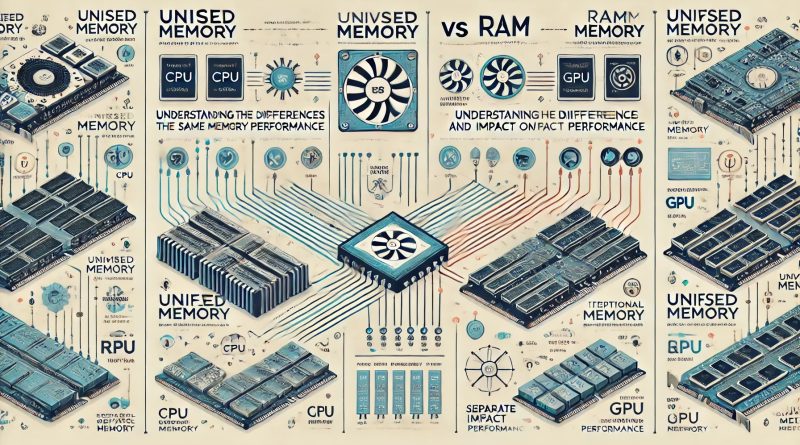Unified Memory vs RAM: Understanding the Differences and Impact on Performance
In the ever-evolving landscape of computing, understanding the nuances of memory types is crucial for optimizing performance and making informed hardware decisions. Two key concepts in this realm are Unified Memory and RAM. Both play pivotal roles in a computer’s performance, but they serve different purposes and operate in distinct ways. In this blog, we’ll delve into Unified Memory vs RAM, exploring their functionalities, benefits, and the scenarios where each shines. We’ll also touch on related topics such as managed vs unmanaged Ethernet switches and UTP cables to provide a broader context for understanding computer systems.
What is RAM?
RAM, or Random Access Memory, is a type of volatile memory used in computers to store data that is actively being used or processed. Unlike storage devices such as SSDs or HDDs, RAM is much faster and provides quick access to data, which is essential for smooth and efficient computing. When you run applications, open files, or perform tasks on your computer, RAM temporarily holds the data that the CPU needs to execute these processes.
The primary function of RAM is to offer high-speed access to data for the CPU, significantly improving system performance and responsiveness. Modern computers typically use DDR (Double Data Rate) RAM, with DDR4 and DDR5 being the most common types in recent years. DDR5, for instance, offers enhanced speed and efficiency compared to its predecessors, making it ideal for high-performance computing tasks.
What is Unified Memory?
Unified Memory is a more recent development in memory technology, primarily associated with Apple’s M1 and M2 chips. Unlike traditional RAM, Unified Memory is a single pool of memory shared between the CPU and GPU. This design allows for more efficient use of memory resources, as it eliminates the need for separate memory pools for different processing units.
In a traditional system, the CPU and GPU have their own dedicated memory, which can lead to inefficiencies. For example, when a task requires both CPU and GPU processing, data must be copied between their respective memory pools, which can cause delays. Unified Memory addresses this issue by providing a shared memory pool that both the CPU and GPU can access directly, reducing data transfer times and improving overall performance.
Unified Memory vs. RAM: Key Differences
- Architecture: The most fundamental difference between Unified Memory and RAM is their architecture. RAM is a standalone memory module that the CPU uses exclusively, while Unified Memory integrates the memory pool shared between the CPU and GPU. This integration allows for better performance in tasks that require simultaneous CPU and GPU processing, such as video editing or gaming.
- Efficiency: Unified Memory enhances efficiency by eliminating the need to transfer data between separate memory pools. This can result in faster performance and reduced latency, particularly in applications that leverage both CPU and GPU capabilities. On the other hand, traditional RAM can experience bottlenecks in scenarios where data needs to be frequently shared between the CPU and GPU.
- Flexibility: With Unified Memory, the allocation of memory resources can be more dynamic. The system can allocate memory to the CPU or GPU as needed, based on the demands of the tasks at hand. In contrast, traditional RAM is fixed and separate from GPU memory, which can lead to underutilization of resources if the demands of the CPU and GPU do not align.
- Compatibility: Unified Memory is a feature specific to certain hardware platforms, such as Apple’s M1 and M2 chips. It is not universally available across all computer systems. RAM, however, is a standard component found in virtually all computers and can be easily upgraded or replaced.
Impact on Performance
The choice between Unified Memory and traditional RAM can significantly impact system performance, depending on the tasks you perform. For general computing tasks, such as web browsing or office work, the difference may be less noticeable. However, for tasks that involve heavy graphical processing or multitasking, Unified Memory can offer superior performance due to its ability to streamline data access and reduce latency.
For instance, in gaming or professional video editing, where both CPU and GPU are heavily utilized, Unified Memory can provide a smoother experience by allowing both processing units to access the same memory pool without the need for redundant data transfers. Conversely, traditional RAM may suffice for less demanding applications, where the efficiency benefits of Unified Memory are less critical.
Related Concepts: Managed vs Unmanaged Ethernet Switches and UTP Cables
While discussing memory types, it’s useful to consider other related components that impact system performance and connectivity, such as managed vs unmanaged Ethernet switch and UTP cables.
- Managed vs Unmanaged Ethernet Switches: Managed switches offer advanced features such as VLAN support, traffic prioritization, and network monitoring. These features provide greater control and optimization of network traffic, which can be crucial in high-performance computing environments. Unmanaged switches, on the other hand, are simpler and lack these advanced features but are often sufficient for basic networking needs. Understanding the differences between managed and unmanaged switches can help in choosing the right network infrastructure for your computing setup.
- UTP Cables: Unshielded Twisted Pair (UTP) cables are commonly used for network connections, including Ethernet. They come in various categories, such as Cat5e and Cat6, which differ in terms of performance and speed. For high-speed networking requirements, such as those involving modern gaming or data-intensive applications, using higher-category UTP cables can ensure optimal performance and minimize latency.
Conclusion
In summary, the choice between Unified Memory and RAM can influence system performance based on your specific needs and usage scenarios. Unified Memory offers advantages in terms of efficiency and performance, particularly for tasks involving both CPU and GPU processing. Traditional RAM, while still essential, operates within a more conventional framework that may not always match the dynamic capabilities of Unified Memory.
Understanding these concepts, along with related elements like managed vs unmanaged Ethernet switches and UTP cables, can help you make more informed decisions about your computing setup. Whether you’re upgrading your computer, setting up a high-performance network, or simply looking to optimize your system, having a clear grasp of these technologies will ensure you achieve the best possible performance for your needs.




